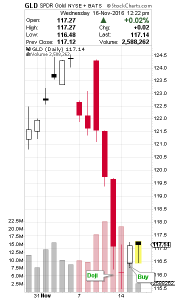Candlesticking GLD & SLV
2. On the first day a black candlestick is observed.
3. Then we see a Doji on the second day that gaps down.
The confirmation level is defined as the midpoint of the gap between the Doji and the previous candlestick. Prices should cross above this level for confirmation.
The stop loss level is defined as the lower of the last two lows. Following the BUY, if prices go down instead of going up, and close or make two consecutive daily lows below the stop loss level, while no bearish pattern is detected, then the stop loss is triggered.
2. A black body is observed on the first day.
3. The white body that is formed on the second day is completely engulfed by the body of the first day.
The confirmation level is defined as the last close or the midpoint of the first black body, whichever is higher. Prices should cross above this level for confirmation.
The stop loss level is defined as the lower of the last two lows. Following the BUY, if prices go down instead of going up, and close or make two consecutive daily lows below the stop loss level, while no bearish pattern is detected, then the stop loss is triggered.

